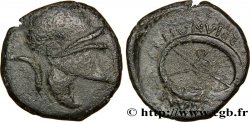Obverse
Obverse legend : ANÉPIGRAPHE.
Obverse description : Mufle de lion vu de face.
Reverse
Reverse legend : INSCRIPTION RÉTROGRADE.
Reverse description : Grain d’orge placé verticalement.
Reverse legend : LE/ON
Reverse translation : (Léontini).
Commentary
Historical background
SICILY - LEONTINOI
(5th - 4th century BC)
Leontini was founded in 729 BC. -VS. by Chalcidians from Naxos. In 496, Leontini came under the influence of Hippokrates, tyrant of Gela before joining the rule of Syracuse with Hieron I twenty years later.. On the death of the tyrant, the city was liberated in 466 BC.. -VS. by establishing democracy. The city was subjugated by Syracuse in 422 BC. -VS. and its inhabitants settled in Syracuse. Leontini with Segesta appealed to Athens to intervene against Syracuse. It was the famous Athens expedition to Sicily that ended in disaster.. Leontini was repopulated by Agrigento, Géla and Camarina and its integrity guaranteed by the Carthaginians after the peace signed by Himilcon. But as early as 403 BC. -VS. Dionysius the Elder seized the city and deported its population. After the death of Dionysius the Elder, Leontini revolted and opened his doors to Dion against Dionysius the Younger. Hiketas settles in Léontini. Hiketas captured Syracuse in 344 BC. -VS. forcing Dionysius the Younger to find refuge on the island of Ortygia. Hiketas returned to Leontini on the arrival of the Corinthian general Timoleon and his mercenaries. Hiketas was finally assassinated. The inhabitants of Léontini left their city again for Syracuse. Hereditary enemies of the Syracusans, the dissidents of Leontini allied themselves with the Carthaginians against Agathokles who, after the intervention of the Akragantain general, Xenodikos, finally remained under Syracusan influence.. The city was then conquered by Pyrrhus during his expedition to Sicily before being integrated into the kingdom of Hieron II. Hieronymos, grandson of Hieron II was assassinated in Leontini who revolted against Syracuse, the Romans and allied himself with the Carthaginians. The city was taken the following year by Marcellus and became a tributary city.










 Report a mistake
Report a mistake Print the page
Print the page Share my selection
Share my selection Ask a question
Ask a question Consign / sell
Consign / sell
 Full data
Full data















